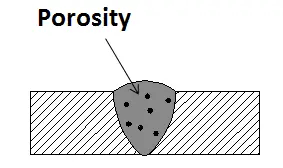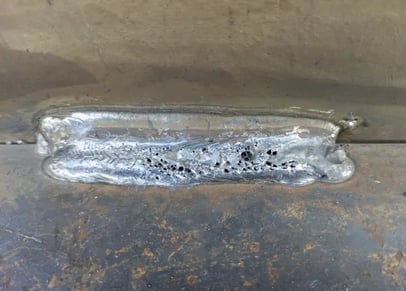Understanding Porosity in Welding: Exploring Reasons, Results, and Avoidance Techniques
As specialists in the welding market are well conscious, recognizing the reasons, impacts, and avoidance methods connected to porosity is critical for accomplishing robust and reliable welds. By diving right into the root creates of porosity, examining its damaging impacts on weld top quality, and exploring effective prevention strategies, welders can improve their understanding and abilities to produce high-grade welds constantly.
Common Causes of Porosity
Porosity in welding is largely triggered by a combination of factors such as contamination, incorrect securing, and inadequate gas coverage throughout the welding procedure. Contamination, in the type of dust, oil, or rust on the welding surface, produces gas pockets when warmed, resulting in porosity in the weld. Improper protecting happens when the protecting gas, frequently used in procedures like MIG and TIG welding, is unable to completely secure the liquified weld pool from reacting with the surrounding air, leading to gas entrapment and succeeding porosity. In addition, poor gas coverage, typically due to inaccurate flow rates or nozzle positioning, can leave parts of the weld unsafe, enabling porosity to create. These aspects collectively add to the formation of gaps within the weld, compromising its stability and potentially triggering architectural issues. Recognizing and addressing these usual causes are vital action in preventing porosity and ensuring the top quality and strength of welded joints.
Results on Weld Top Quality
The existence of porosity in a weld can dramatically compromise the overall high quality and stability of the welded joint. Porosity within a weld creates gaps or tooth cavities that weaken the framework, making it a lot more at risk to splitting, corrosion, and mechanical failing. These voids act as tension concentrators, reducing the load-bearing capacity of the weld and raising the possibility of premature failure under used anxiety. Furthermore, porosity can also serve as possible websites for hydrogen entrapment, additional aggravating the degradation of the weld's mechanical residential properties.
Furthermore, porosity can impede the performance of non-destructive testing (NDT) strategies, making it testing to detect other problems or interruptions within the weld. This can bring about substantial security problems, particularly in critical applications where the structural stability of the bonded parts is extremely important.

Prevention Techniques Introduction
Offered the destructive influence of porosity on weld high quality, efficient prevention methods are crucial to keeping the structural integrity of welded joints. One of the key prevention methods is extensive cleaning of the base products before welding. Pollutants such as oil, oil, rust, and moisture can add to porosity, so making certain a clean work surface area is important. Correct storage of welding consumables in completely dry conditions is also important to avoid wetness absorption, which can bring about gas entrapment during welding. Additionally, selecting the proper welding criteria, such as voltage, present, and take a trip speed, can assist reduce the risk of porosity development. Making certain appropriate securing gas flow and protection is an additional vital avoidance strategy, as insufficient gas protection can cause atmospheric contamination Extra resources and porosity. Ultimately, correct welder training and accreditation are important for implementing safety nets properly and regularly. By including these avoidance techniques into welding practices, the occurrence of porosity can be dramatically decreased, causing more powerful and a lot more trusted welded joints.
Importance of Proper Shielding
Proper securing in welding plays an essential role in stopping climatic contamination and making sure the stability of welded joints. Securing gases, such as argon, helium, or a mix of both, are commonly made use of to safeguard the weld swimming pool from responding with elements airborne like oxygen and nitrogen. When these reactive elements enter into call with the hot weld pool, they can create porosity, resulting in weak welds with minimized mechanical buildings.

Inadequate protecting can lead to various flaws like porosity, spatter, and oxidation, compromising the structural integrity of the welded joint. Therefore, sticking to proper shielding techniques is vital to produce high-quality welds with marginal issues and make sure the durability and reliability of the welded components (What is Porosity).
Tracking and Control Approaches
Just how can welders properly keep an eye on and manage the welding process to ensure optimum results and stop issues like porosity? One key method is via making use of innovative surveillance innovations. These can consist of real-time monitoring systems that give comments on specifications such as voltage, present, take a trip speed, and gas flow rates. By constantly keeping an eye on these variables, welders can determine inconsistencies from the excellent conditions and make instant changes to protect against porosity formation. find more information

In addition, executing appropriate training programs for welders is essential for monitoring and managing the welding process successfully. What is Porosity. Enlightening welders on the significance of maintaining regular specifications, such as correct gas protecting and travel speed, can assist protect against porosity issues. Regular assessments and accreditations can likewise ensure that welders excel in monitoring and regulating welding processes
Furthermore, making use of automated welding systems can improve surveillance official website and control abilities. These systems can specifically control welding parameters, reducing the probability of human error and making sure consistent weld quality. By incorporating sophisticated tracking modern technologies, training programs, and automated systems, welders can efficiently check and control the welding procedure to minimize porosity issues and accomplish high-grade welds.
Final Thought
